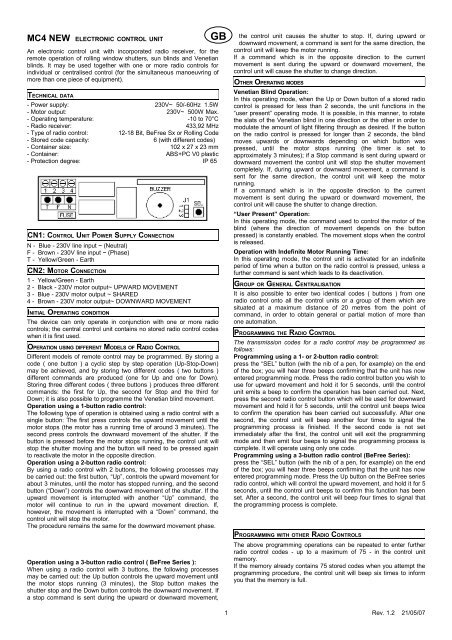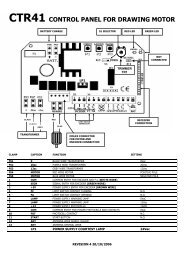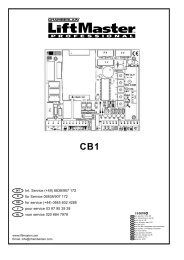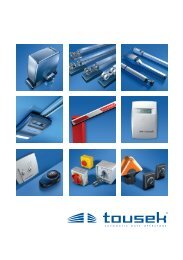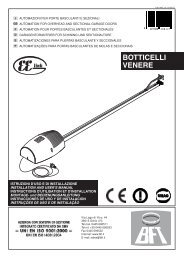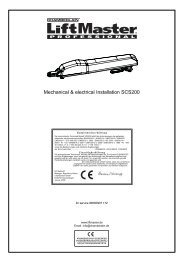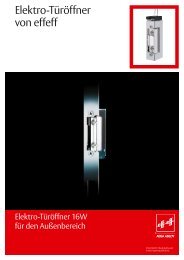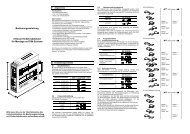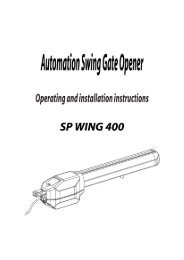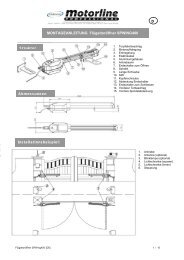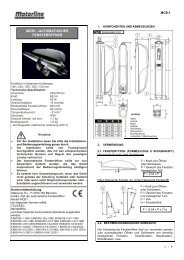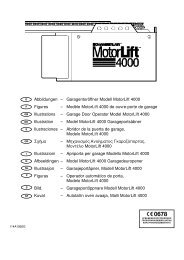QUADRO ELETTRONICO LRx 2074VN - Nothnagel
QUADRO ELETTRONICO LRx 2074VN - Nothnagel
QUADRO ELETTRONICO LRx 2074VN - Nothnagel
You also want an ePaper? Increase the reach of your titles
YUMPU automatically turns print PDFs into web optimized ePapers that Google loves.
MC4 NEW ELECTRONIC CONTROL UNIT<br />
An electronic control unit with incorporated radio receiver, for the<br />
remote operation of rolling window shutters, sun blinds and Venetian<br />
blinds. It may be used together with one or more radio controls for<br />
individual or centralised control (for the simultaneous manoeuvring of<br />
more than one piece of equipment).<br />
TECHNICAL DATA<br />
- Power supply: 230V~ 50/-60Hz 1.5W<br />
- Motor output: 230V~ 500W Max.<br />
- Operating temperature: -10 to 70°C<br />
- Radio receiver: 433,92 MHz<br />
- Type of radio control: 12-18 Bit, BeFree Sx or Rolling Code<br />
- Stored code capacity: 6 (with different codes)<br />
- Container size: 102 x 27 x 23 mm<br />
- Container: ABS+PC V0 plastic<br />
- Protection degree: IP 65<br />
CN1: CONTROL UNIT POWER SUPPLY CONNECTION<br />
N - Blue - 230V line input ~ (Neutral)<br />
F - Brown - 230V line input ~ (Phase)<br />
T - Yellow/Green - Earth<br />
CN2: MOTOR CONNECTION<br />
1 - Yellow/Green - Earth<br />
2 - Black - 230V motor output~ UPWARD MOVEMENT<br />
3 - Blue - 230V motor output ~ SHARED<br />
4 - Brown - 230V motor output~ DOWNWARD MOVEMENT<br />
INITIAL OPERATING CONDITION<br />
The device can only operate in conjunction with one or more radio<br />
controls; the central control unit contains no stored radio control codes<br />
when it is first used.<br />
OPERATION USING DIFFERENT MODELS OF RADIO CONTROL<br />
GB<br />
Different models of remote control may be programmed. By storing a<br />
code ( one button ) a cyclic step by step operation (Up-Stop-Down)<br />
may be achieved, and by storing two different codes ( two buttons )<br />
different commands are produced (one for Up and one for Down).<br />
Storing three different codes ( three buttons ) produces three different<br />
commands: the first for Up, the second for Stop and the third for<br />
Down; it is also possible to programme the Venetian blind movement.<br />
Operation using a 1-button radio control:<br />
The following type of operation is obtained using a radio control with a<br />
single button: The first press controls the upward movement until the<br />
motor stops (the motor has a running time of around 3 minutes). The<br />
second press controls the downward movement of the shutter. If the<br />
button is pressed before the motor stops running, the control unit will<br />
stop the shutter moving and the button will need to be pressed again<br />
to reactivate the motor in the opposite direction.<br />
Operation using a 2-button radio control:<br />
By using a radio control with 2 buttons, the following processes may<br />
be carried out: the first button, “Up”, controls the upward movement for<br />
about 3 minutes, until the motor has stopped running, and the second<br />
button (“Down”) controls the downward movement of the shutter. If the<br />
upward movement is interrupted with another “Up” command, the<br />
motor will continue to run in the upward movement direction. If,<br />
however, the movement is interrupted with a “Down” command, the<br />
control unit will stop the motor.<br />
The procedure remains the same for the downward movement phase.<br />
Operation using a 3-button radio control ( BeFree Series ):<br />
When using a radio control with 3 buttons, the following processes<br />
may be carried out: the Up button controls the upward movement until<br />
the motor stops running (3 minutes), the Stop button makes the<br />
shutter stop and the Down button controls the downward movement. If<br />
a stop command is sent during the upward or downward movement,<br />
the control unit causes the shutter to stop. If, during upward or<br />
downward movement, a command is sent for the same direction, the<br />
control unit will keep the motor running.<br />
If a command which is in the opposite direction to the current<br />
movement is sent during the upward or downward movement, the<br />
control unit will cause the shutter to change direction.<br />
OTHER OPERATING MODES<br />
Venetian Blind Operation:<br />
In this operating mode, when the Up or Down button of a stored radio<br />
control is pressed for less than 2 seconds, the unit functions in the<br />
“user present” operating mode. It is possible, in this manner, to rotate<br />
the slats of the Venetian blind in one direction or the other in order to<br />
modulate the amount of light filtering through as desired. If the button<br />
on the radio control is pressed for longer than 2 seconds, the blind<br />
moves upwards or downwards depending on which button was<br />
pressed, until the motor stops running (the timer is set to<br />
approximately 3 minutes); if a Stop command is sent during upward or<br />
downward movement the control unit will stop the shutter movement<br />
completely. If, during upward or downward movement, a command is<br />
sent for the same direction, the control unit will keep the motor<br />
running.<br />
If a command which is in the opposite direction to the current<br />
movement is sent during the upward or downward movement, the<br />
control unit will cause the shutter to change direction.<br />
“User Present” Operation:<br />
In this operating mode, the command used to control the motor of the<br />
blind (where the direction of movement depends on the button<br />
pressed) is constantly enabled. The movement stops when the control<br />
is released.<br />
Operation with Indefinite Motor Running Time:<br />
In this operating mode, the control unit is activated for an indefinite<br />
period of time when a button on the radio control is pressed, unless a<br />
further command is sent which leads to its deactivation.<br />
GROUP OR GENERAL CENTRALISATION<br />
It is also possible to enter two identical codes ( buttons ) from one<br />
radio control onto all the control units or a group of them which are<br />
situated at a maximum distance of 20 metres from the point of<br />
command, in order to obtain general or partial motion of more than<br />
one automation.<br />
PROGRAMMING THE RADIO CONTROL<br />
The transmission codes for a radio control may be programmed as<br />
follows:<br />
Programming using a 1- or 2-button radio control:<br />
press the “SEL” button (with the nib of a pen, for example) on the end<br />
of the box; you will hear three beeps confirming that the unit has now<br />
entered programming mode. Press the radio control button you wish to<br />
use for upward movement and hold it for 5 seconds, until the control<br />
unit emits a beep to confirm the operation has been carried out. Next,<br />
press the second radio control button which will be used for downward<br />
movement and hold it for 5 seconds, until the control unit beeps twice<br />
to confirm the operation has been carried out successfully. After one<br />
second, the control unit will beep another four times to signal the<br />
programming process is finished. If the second code is not set<br />
immediately after the first, the control unit will exit the programming<br />
mode and then emit four beeps to signal the programming process is<br />
complete. It will operate using only one code.<br />
Programming using a 3-button radio control (BeFree Series):<br />
press the “SEL” button (with the nib of a pen, for example) on the end<br />
of the box; you will hear three beeps confirming that the unit has now<br />
entered programming mode. Press the Up button on the BeFree series<br />
radio control, which will control the upward movement, and hold it for 5<br />
seconds, until the control unit beeps to confirm this function has been<br />
set. After a second, the control unit will beep four times to signal that<br />
the programming process is complete.<br />
PROGRAMMING WITH OTHER RADIO CONTROLS<br />
The above programming operations can be repeated to enter further<br />
radio control codes - up to a maximum of 75 - in the control unit<br />
memory.<br />
If the memory already contains 75 stored codes when you attempt the<br />
programming procedure, the control unit will beep six times to inform<br />
you that the memory is full.<br />
1 Rev. 1.2 21/05/07
INVERSION OF THE ROTATION MOTOR<br />
If you notice that when pressing the ( Up ) key on the radio-control the<br />
control unit causes the shutter to move downwards instead of<br />
upwards, simply repeat the programming procedure pressing the<br />
( Down ) key instead of the ( Up ) key, or invert the Upward movement<br />
wire and the Downward movement wire of the motor.<br />
PROGRAMMING VENETIAN BLIND OPERATION<br />
To activate this operating mode, move the jumper J1 (located on the<br />
board, inside the plastic container) from position 2-3 to position 1-2.<br />
Perform this procedure with the control unit disconnected from the 230<br />
V electricity supply.<br />
PROGRAMMING “USER PRESENT” BLIND OPERATION<br />
To activate this operating mode, remove the jumper J1 (located on the<br />
board, inside the plastic container). Perform this procedure with the<br />
control unit disconnected from the 230 V electricity supply.<br />
PROGRAMMING INDEFINITE MOTOR TIME<br />
To set unlimited motor time proceed as follows: press and hold the<br />
SEL button while the control unit is connected to the electricity supply,<br />
until the control unit emits seven confirmation beeps. To restore the<br />
three-minute motor running time, repeat the operation described above<br />
or perform the Reset procedure.<br />
RESET WITH THE “SEL” BUTTON<br />
To restore the control unit to its default configuration, proceed as<br />
follows. press and hold the SEL button for 5 seconds, until the control<br />
unit beeps five times to confirm that the operation is complete.<br />
BEEP SIGNALS<br />
1 BEEP = First radio control code stored.<br />
2 BEEPS = Second radio control code stored.<br />
3 BEEPS = Start of programming phase.<br />
4 BEEPS = End of programming phase.<br />
5 BEEPS = Restoration of default configuration.<br />
6 BEEPS = No more memory available for new codes.<br />
7 BEEPS = Motor running time programming.<br />
FOR THE USER - IMPORTANT<br />
- The device should not be used by children or by individuals with<br />
reduced physical or psychological abilities unless supervision is<br />
provided or instruction given on how to operate it.<br />
- Do not let children play with the device; keep radio controls out of<br />
their reach.<br />
- CAUTION: Keep this instruction manual in a safe place and<br />
adhere to the important safety instructions contained within it. Nonadherence<br />
to these instructions may lead to property damage and<br />
serious accidents.<br />
- Examine the system frequently to check for any signs of damage.<br />
Do not use the device if it needs to be repaired.<br />
- If the wires have to be replaced (for the power supply or for the<br />
motor output), contact a qualified technician only.<br />
FOR THE INSTALLER - IMPORTANT<br />
The control unit was designed to enable the installer to automate<br />
closure while adhering to the provisions set out by current legislation.<br />
Compliance with these obligations and the implementation of the<br />
minimum safety requirements is the responsibility of the installer. Once<br />
installation has been completed in full compliance with EN 60335-2-97<br />
(“Household and similar electrical appliances - Safety”, part 2<br />
“Particular requirements for drives for rolling shutters, awnings, blinds<br />
and similar equipment”), make sure that:<br />
There are no accidental movements.<br />
There are no movements which were not requested caused<br />
by variations in the voltage and electricity supply.<br />
The force of impact at the main closure edge does not<br />
exceed:<br />
- 25 N for more than 5 s<br />
- 150 N for more than 0.5 s.<br />
If the latter provision is not satisfied, the “User Present”<br />
function can be used as an alternative, to obtain non selfholding<br />
release command operation. In this case the radio<br />
control must only be used while<br />
the user is in full view of the rolling device (perhaps<br />
fixing it to the wall would ensure this).<br />
We also advise that you take note of the following recommendations:<br />
- For the radio receiver to operate correctly when two or more control<br />
units are used, we recommend that you install the devices at least 3<br />
metres away from each other.<br />
− The control unit is not equipped with a sectioning device. The<br />
installer is therefore responsible for the installation of a sectioning<br />
device in the system.<br />
Stateurop hereby declares that the product below:<br />
MC4<br />
Comply with the requirements of Directives R&TTE 99/5/EC,<br />
EMC 2004/108/EC, LVD 2006/95/EC.<br />
2 Rev. 1.2 21/05/07


